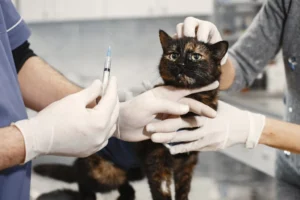Picture this: it’s 2 am, and you’re awakened by the piercing cries of your beloved feline friend, who’s frantically seeking a mate outside your window.
Or maybe you’ve just brought home your sixth litter of kittens, and you’re starting to wonder if you’re becoming the neighborhood’s “crazy cat person.”
If any of these scenarios sound familiar, spaying or neutering your cat might just be the solution you need. In addition, it has many health and behavioral benefits for cat as well.
Let’s dive into the world of feline population control and find out how it benefits both you and your furry companion.

Why Spay or Neuter Your Cat?
The decision to spay or neuter your cat is a responsible one, with numerous advantages for you, your feline friend, and the broader community.
For starters, it helps control the cat population, preventing the overburdening of shelters and reducing the number of homeless cats on the streets.
Additionally, spaying and neutering have health benefits for your pet, such as reducing the risk of certain cancers and infections.
By opting for these procedures, you’re not only improving your cat’s quality of life but also doing your part in addressing the bigger picture of pet overpopulation. So let’s explore further the benefits, procedures, and best practices of spaying and neutering.
The Benefits of Spaying and Neutering
It’s essential to understand the full scope of benefits that come with spaying and neutering your cat.
Not only does it impact your cat’s well-being, but it also has a ripple effect on the feline community. Here’s a comprehensive list of the advantages:
- Healthier pets. Spaying and neutering can reduce the risk of certain cancers, infections, and other health issues in cats.
- Reduced aggression. Neutered male cats are less likely to display aggressive behaviors, such as fighting with other cats.
- Prevents unwanted litters. Spaying and neutering help control the cat population, easing the burden on shelters and reducing the number of homeless cats.
- Decreased marking. Neutering male cats can reduce or eliminate urine marking, making your home more pleasant.
- Lower roaming tendencies. Spayed and neutered cats are less likely to roam, minimizing their risk of getting lost or injured.
With the various advantages of spaying and neutering laid out before us, it becomes clear that these procedures significantly enhance our cats’ quality of life and contribute to a healthier feline community.
Let’s take these benefits to heart and ensure that our furry companions live their best lives while promoting responsible pet ownership.
What Do the Procedures Involve?
Understanding what spaying and neutering entail can help put your mind at ease when considering these procedures for your feline friend.
Spaying, or ovariohysterectomy, is a surgical procedure in which a female cat’s ovaries and uterus are removed, while neutering, or castration, involves removing a male cat’s testicles.
When I took my cat Smokey to be neutered, I was initially worried about the procedure. However, the veterinarian walked me through the entire process, explaining that both spaying and neutering are routine surgeries performed under general anesthesia.
Your cat will be closely monitored throughout the procedure, ensuring their safety and comfort. After the surgery, the vet will provide you with specific instructions for post-operative care, including pain management, wound care, and activity restrictions.
Remember, it’s essential to follow these guidelines to ensure a smooth recovery for your cat.

When is the Best Time to Spay or Neuter Your Cat?
Most veterinarians recommend scheduling the procedure when your cat is between four and six months old. This age range allows kittens to benefit from the procedure before they reach sexual maturity while minimizing potential complications related to their growth and development.
However, it’s never too late to spay or neuter an adult cat, as they can still experience the health and behavioral benefits.
My cat’s experience:
Preparing Your Cat for Surgery: What to Expect
Your veterinarian will provide you with specific pre-operative instructions, which may include fasting your cat for several hours before the procedure. Make sure you follow these instructions to ensure a smooth and safe surgery.
On the day of Smokey’s neutering, I was a bundle of nerves. The clinic staff, however, were reassuring and explained the entire process. They informed me that, during surgery, Smokey would be under general anesthesia, and a veterinary team would monitor his vital signs to ensure his safety.
I was also told to expect some grogginess and mild discomfort for Smokey after the surgery, which is normal.
After the procedure, your veterinarian will give you guidelines for post-operative care. These may include administering pain medication, monitoring the incision site for signs of infection, and restricting your cat’s activity for a few days. Following these instructions carefully will help your cat recover quickly and comfortably.
Potential Risks and Post-Operative Care
While spaying and neutering are generally safe procedures, it’s important to be aware of potential risks and complications.
Some cats may experience an adverse reaction to anesthesia, bleeding, or infection at the incision site. However, these are rare. With proper post-operative care, these risks can be minimized, ensuring your cat recovers quickly and comfortably.
Monitor the incision site for any redness, swelling, or discharge. Also, make sure to keep your cat indoors and restrict their activity for about a week to prevent any complications.
Common Misconceptions and Concerns
Myth: Spaying or neutering will make my cat overweight.
Fact: Cats may gain weight after the procedure, but this is typically due to overfeeding or lack of exercise. Monitor your cat’s diet and ensure they get regular playtime to maintain a healthy weight.
Myth: My cat’s personality will change after spaying or neutering.
Fact: While some hormone-driven behaviors may decrease, your cat’s overall personality should remain the same. In fact, many pet owners notice positive changes, such as reduced aggression and less marking.
Myth: Spaying or neutering is too expensive.
Fact: While not exactly a “myth” rather a miscalculation on the owner’s part. The cost of spaying or neutering is a one-time expense that can save you money in the long run by preventing health issues and unwanted litter. Many clinics and organizations offer low-cost or subsidized options for pet owners.
Myth: Indoor cats don’t need to be spayed or neutered.
Fact: Even indoor cats can benefit from spaying or neutering. The procedures not only prevent unwanted litters but also offer significant health and behavioral benefits that improve your cat’s quality of life.
FAQs
Are there any alternatives to surgical spaying/neutering?
While there are alternative methods like chemical sterilization, these options are less common and may have limitations in terms of effectiveness and availability.
How can I tell if my cat is experiencing complications after surgery?
Monitor your cat for symptoms like excessive swelling, redness, discharge at the incision site, lethargy, or loss of appetite, which could indicate complications.
Will spaying/neutering change my cat’s behavior or personality?
Spaying/neutering may decrease hormone-driven behaviors, such as aggression or marking, but your cat’s overall personality should remain intact.
Can I spay/neuter a pregnant or nursing cat?
It’s possible to spay a pregnant cat, but the procedure carries additional risks. Consult your veterinarian for guidance, and ideally, wait until the cat has finished nursing her kittens before spaying/neutering.
Alex, a passionate animal lover, has experience in training and understanding animal behavior. As a proud pet parent to two dogs and three cats, he founded AnimalReport.net to share insights from animal experts and expand his knowledge of the animal kingdom.









